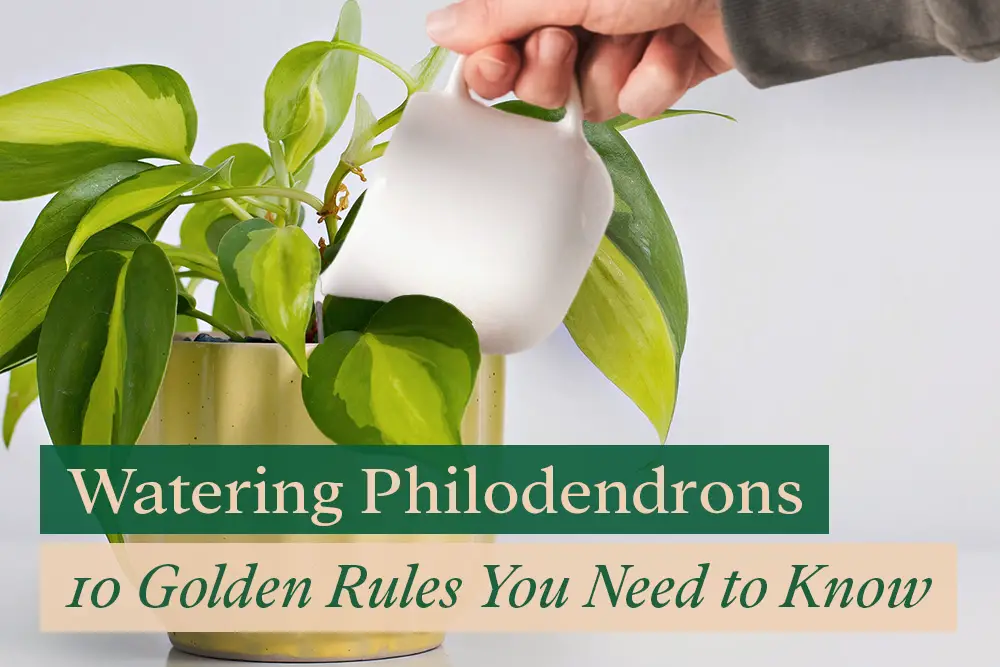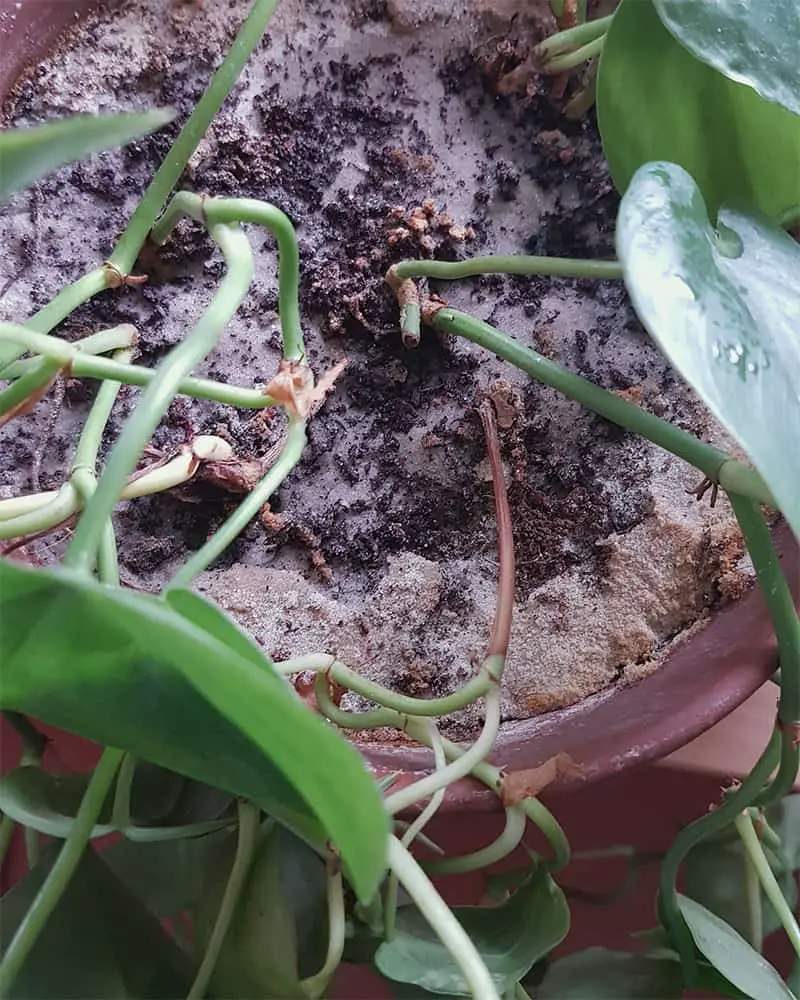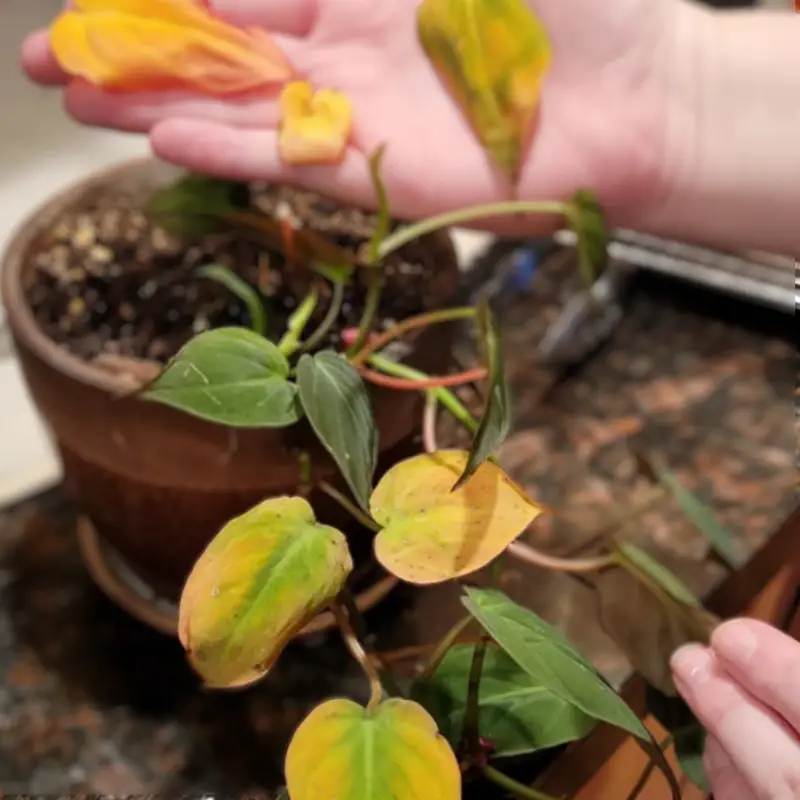
As you probably already know, all plants, including Philodendrons, require water to thrive. Unfortunately, you might not be aware that incorrect watering techniques can promote disease in your Philodendrons, even leading to their death.
In this article, I will cover everything you need to know about watering Philodendron plants:
- How often to water Philodendrons
- Factors that affect the watering schedule
- How much to water your Philodendrons
- Best type of water for Philodendrons
- Signs and treatment for underwatered or overwatered Philodendrons
- Tips for watering Philodendrons in Winter
- Growing Philodendron in water
- Watering technique: Bottom vs Top Watering
- Watering after repotting and propagating
- Self-watering pot: should you use it for Philodendron?
Let’s get started!
How Often To Water Philodendron Plants
Generally, Philodendrons need watering once a week. However, the frequency of watering may vary depending on the temperature, humidity and quality of the soil.
It’s best to let the upper surface of the soil dry before watering. You can check the extent of dryness by digging in with your fingers or overturning the upper layer with a hand shovel.
If the dryness extends up to an inch (2.5 cm) below the surface, it’s time to water your philodendron.
You shouldn’t add more water while the soil is still moist as it may lead to over-watering and damage your philodendron by causing the roots to rot.
This disease may have irreversible effects, so don’t worry if the soil dries up a bit between watering.
Factors That Affect How Often To Water Your Philodendron
As discussed, several factors affect how frequently you water your philodendron.
Every geographical area has a different soil condition based on seasonal changes, so you can benefit from understanding your region’s climate conditions.
Here are some factors to consider when watering your philodendron:
Temperature & Humidity
Higher temperatures can cause moisture in the soil to evaporate before the roots can absorb most of it. Due to this phenomenon, it’s best to check the soil condition and water your philodendrons more often in the summer.
In addition to checking the soil, it’ll also help to monitor the leaves’ conditions.
Philodendrons are native to tropical rainforests in South America, where they prefer high humidity. Without which their leaves will lose their quality and appearance.
If you notice your philodendron leaves drooping or browning along the tips and edges, it may be a sign that it’s not getting enough water.
When the humidity in your room falls below 40%, you should turn on your plant humidifier at least for 6 hours to provide enough moisture for your Philodendron. Avoid misting the leaves directly as they’re prone to microbial infection.
You should also take into account your philodendron’s location when it comes to its ability to tolerate water loss.
For instance, a philodendron plant that grows indoors may need less watering than one that grows outdoors. Direct sunlight can lead to a rise in temperature and a loss of moisture through evaporation and transpiration.
Also read: Watering Plants in the Sun – Is it Safe?
Soil Mix Content
Philodendrons thrive best in airy and well-draining soil. If these requirements are met, it’s safe to water your plant often without worrying that it might be over-watered.

The loose soil mix, along with sufficient sunlight, will drain the excess water.
Adding peat moss to loose soil can help with moisture retention, allowing you to water less frequently.
Therefore, it’s helpful to consider the ingredients used in the soil mix to understand how frequently you must water your plant.
How Much To Water Philodendrons
Philodendron water requirements depend largely on the soil mix content.
As discussed above, a loose medium with good drainage will be effective in removing excess water. However, avoid pouring too much water at once.
Here’s how you can sufficiently water philodendrons:
- You can pour in one cup (approx. 250 ml) of water at a time if an inch (2.5 cm) of upper soil surface appears dry.
- Let the soil absorb the water before adding more. Pour the excess water into the soil if it is no longer able to absorb water.
- Let the pot rest on a sink for up to 30 minutes as the water drains out from the drainage holes.
Remember, you should remove any excess water from saucers under your pots since stagnant water can harm philodendrons and serve as a breeding ground for mosquitoes.
The Best Kind of Water for Your Philodendron
Philodendrons are famous for their beautiful foliage, and some species, such as the Philodendron Pink Princess, are moderately sensitive to certain elements commonly found in tap water, like chlorine.
For instance, concentrations of 400 mg/L of chlorine or higher can cause leaf stress.
Luckily, you can remove chlorine naturally from tap water through evaporation by leaving the water to stand for half a day.
For a quick removal process and to reduce the work involved with storing excess water, you may also use carbon filters to remove chlorine.
Distilled water is best for philodendrons because it’s free from chemicals or substances that may be harmful to them. However, it can be pretty expensive.
Therefore, carbon-filtered water or tap water left to stand for a day would be the best option. You can supplement any missing nutrients by applying fertilizers to the soil.
How To Tell if Your Philodendron Is Underwatered
It is easy to forget to water your Philodendron if you travel frequently or have a busy schedule. While Philodendrons are relatively resistant to drought, prolonged dry periods can kill the plant.
How Long Can Philodendron Go Without Water?
Generally, Philodendrons can survive up to 2 weeks without water, but are subject to factors such as the size of the plant, the humidity and temperature of the area where they’re growing.
A small plant exposed to a hot and dry area without water will die once it uses up the little water it has left in its roots and stems.
Larger philodendrons in temperate climates may survive longer by slowing down the dehydration process, which begins at the tips of the leaves and moves towards the water-conducting vessels in the stem.
This ability to slow the drying process is why even when the leaves appear dry the inside of the stem retains its moisture.
Also read: Factors Affecting How Long Can Plants Go Without Water?
Signs Philodendron Is Under-Watered
In the plant world, certain symptoms can signal various issues.
For example, browning on multiple parts of the leaves can be a sign of numerous problems, like sunburn, pests, or infection.

However, there are certain clear signs of an under-watered philodendron plant.
- Drooping leaves
- Leaves shrivel or curl up from the tips
- Browning along the leaf tip and edges
- Dry, cracked soil
- Stunted growth
Can Philodendron Recover From Drooping?
Some negative effects of under-watering, such as browning of the leaves, are irreversible and you may need to pluck out the affected leaves.
However, you can fix some symptoms with adequate attention and care.
Providing deep watering and maintaining a regular watering schedule can help Philodendrons recover from drooping. Giving your plant water-soluble fertilizer rich in nitrogen can also help grow new perky leaves with lively green color.
How To Tell if You Are Watering Philodendron Too Often
Some plant owners assume that philodendrons need the same amount of water as other house plants.
However, it’s important to remember that philodendrons are less tolerant to over-watering, and excess moisture can be fatal.
What Often Cause Overwatering
One of the most obvious causes of over-watering is when you water your plant too often.
However, in some cases you may water your philodendron once a week, and yet, you still see signs of overwatering. A few factors may contribute to this:
- You may not be using a suitable medium. The soil mix might be too compact, holding more water than necessary for a longer period. As a result, the roots suffer from constant exposure to high moisture.
- The design and quality of the pots may be poor. Using pots with poor drainage (no drainage hole) or those made from materials with low aeration capacity, like plastic, can result in high moisture retention and plant damage.
- Accumulated water isn’t being removed. Ensure you remove any stagnant water from the plant saucer so the soil isn’t moist and over-watered.
Signs Philodendron Is Over-Watered
In contrast to under-watering, where leaves turn dry and brown along the edges, over-watering can turn some leaves yellow.

You may also notice Philodendron leaves wilting as they’re unable to breathe properly due to excess water in the roots and leaves. Yellowing and deformed leaves are also signs of severe root rot caused by overwatering, as fungi thrive in warm, water-logged soil.
Over-watering and high humidity can also promote the growth of some types of bacteria, such as Xanthomonas and Erwinia, that can attack a vulnerable philodendron plant, causing root rot and spot formation on the leaves.
How To Fix an Over-Watered Philodendron
Most problems caused by over-watering philodendrons are often irreversible if not addressed immediately.
For instance, bacterial and fungal infections may spread throughout the plant and infect neighboring plants.
However, in the early-stages of fungal infection, when the root rot has just set in, it’s still possible to save your philodendron.
- First off, pull the plant out of the pot carefully and place the roots under running water. When the soil has been washed off, you can inspect how far the infection has spread.
- Dark, mushy roots indicate infection. You can easily and quickly remove them using a sterile knife or scissors.
- It’s necessary to identify the type of fungus that infected your plant so you can figure out which fungicide to use. When you find the best option for your plant, soak the roots in the solution to remove any leftover fungi.
- You can now wash the plant thoroughly and replant it in a new pot with a fresh and sterile potting mix.
In case of a bacterial infection, where most leaves have yellow spots or water-soaked lesions, it’s best to throw the plant away along with the contaminated soil.
However, if you think it’s still worth saving, start the recovery process by cutting off infected leaves.
Avoid misting infected plants as they can spread the infection to other healthy leaves. Excess moisture on the leaf surface makes it the ideal breeding ground for bacteria that cause leaf blights.
If the problem doesn’t involve bacterial or fungal infection, you can try simply re-potting your philodendron. It’s best to ensure that the soil is loose with excellent drainage, and the pot is breathable enough to reduce the risk of overwatering.
How Often To Water Philodendron in Winter
The watering schedule in winter can be tricky as the low temperatures reduce water loss from the soil.
In contrast, the low humidity reduces the amount of moisture the philodendrons can absorb through their aerial roots.
During winter, you should water Philodendrons only when the top inches of soil is completely dry. In most cases, this means once every two weeks.
You can also set up a humidifier next to your philodendron during winter, so it can benefit from the higher humidity.
Using a plant humidifier at least 4 hours a day, is another solution to the lack of moisture in the environment.
Also, consider grouping your other house plants together in an area around your philodendron as this will help boost humidity levels in the room.
Can Philodendrons Grow in Water?
Philodendrons are easy to grow because they require minimal care so long as their basic needs of light, water, and soil are met.
It’s also quite straightforward to propagate a philodendron because you only need stem cuttings to do so.
Philodendron cuttings grow well in water, where they develop healthy roots and can be transplanted into an appropriate medium. It’s best to use filtered or distilled water to ensure that the cuttings don’t die from chlorine or fluorine in tap water.
When cutting a stem to propagate in water, ensure you use sterile scissors to avoid microbial contamination.
Cut at least an inch (2.5 cm) below a node with protruding roots and leaves. Submerge the roots in a jar of filtered water and be sure to replace the water at least once a week so your philodendron grows properly.
Should I Water From Above or Below?
As you might know, there are two ways of watering your houseplant. One way is to let water seep through the root ball by pouring it over the top, directly into the potting mix.
A second method is to water the plant from the bottom, by pouring water into the saucer and letting the plant absorb it.
Bottom watering is great as it keeps the soil uniformly moist, but salts can accumulate over time. On the other hand, top watering can help flush out salt buildup, but if not done properly, it can cause a lack of water supply in the soil if the moisture does not reach the entire root structure.
It is best to water your plant regularly from the bottom and then switch to top watering once every 6 weeks. This will allow the salt to be flushed from the soil. Ensure that water drains out of the drainage hole.
Should I Water Philodendrons After Repotting?
Philodendrons grow relatively quickly and need repotting every two years. Ensure that you use a fresh and sterile potting mix in a breathable pot with excellent drainage. This new pot shouldn’t be more than an inch (2.5 cm) wider and taller than the first one.
You should water the philodendron thoroughly after repotting and let the pot sit on the sink until all the excess moisture drains out. After the initial watering, you may water the plant as you normally did before it was repotted.
Should I Water Philodendrons After Propagation?
There are two ways of propagating philodendrons
- Placing stem cuttings into a jar of filtered water.
- Planting root cuttings into soil.
Either way, as soon as the cuttings grow enough roots and leaves, they have to be transplanted into a fresh potting mix.
You should water philodendrons after propagation when they’ve been placed in a fresh and sterile potting mix. Let the excess moisture drain out of the holes to ensure that the plant isn’t over-watered.
Is a Self-Watering Pot a Great Option for Philodendron?
Self-watering pots are gaining popularity nowadays, especially for plant owners who are too busy to keep a plant-watering schedule.
These pots help maintain moisture content by conducting water from a reservoir into the soil.
A self-watering pot isn’t a great option for philodendrons. They don’t benefit much from them because they prefer to dry out a bit between watering schedules. It’s best to manually add water into the pot after checking the extent of soil dryness.

